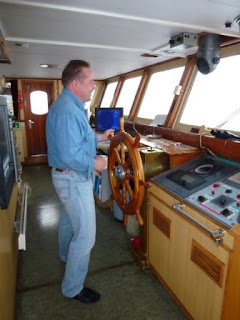We have just had four of the most beautifully sunny and warm days. Today in particular is quite magical – it is almost calm and the sea is like Mediterranean in summer. We are making good progress with speeds up to 9.5 knots today. After some initial sea sickness I seem to have found my sea legs. We are settling into a routine of eating, chatting, strolling around on deck and watching films on DVD in the evening. There is even an exercise bike and I’ve been doing about 15 minutes a day on it.
Gert the Engineer gave us a guided tour of the engine room today – which is immaculately clean and well polished. The engine is a 6 cylinder water cooled 96 litre turbo diesel. The radiator is cooled by sea water and amazingly not much bigger than the one in my car (and runs a lot cooler). It starts using a compressed air turbine. There are also 4 electricity generators for the engine auxiliaries, the ships crane, instruments, communications, cooking, and refrigeration in the galley and lighting. Also for the ship’s desalination plant which supplies us with water. Top speed is about 10.5 knots but they run it slower to avoid stressing it out.
Ok I think I’ve figured out what bird species I’ve been seeing. I’ve been using Ryan’s Field Guide to the Animals and Plants of Tristan da Cunha and a borrowed Birds of Southern Africa by Sinclair. The tentative list so far is:
Wandering Albatross – really big with a rather ugly big pink bill, white underwing with black trailing edge and the grey wings. There are a lot of confusing variations in plumage depending on whether the bird is juvenile, immature, sub-adult or adult. But I did wonder if we also had another entirely different species – the Southern Royal Albatross – a massive bird with 3.5 metre wingspan. Albatrosses are amazing to watch they never seem to flap their wings and seem to spend all day effortlessly gliding along often just inches above the waves.
Pintado Petrel – this is the most distinctive of all the birds with beautiful black and white mottled wings – and also one of the most common. They seem to love following the ship in ones and twos.
Blue Petrel – I only saw a few of these yesterday, I think. They have a distinctive dark M shape across their wings. Quite similar to Prions, but I think I’ve understood the difference.
Great-winged Petrel – we’ve been followed most of the morning by a group of five or six and that has given me a chance to have a good look at these birds, which I initially thought were Skuas. Like Skuas they are mostly brown with triangular tail fin outline. But these are petrels and have silvery highlights on both upper and lower wings.
Wilson’s Storm Petrel – Nice to see this old friend recognisable from the North Atlantic. The smallest bird species to be seen with that very distinctive white rump.
If you’d like a copy of Ryan’s book, which I can thoroughly recommend, Summerfield (BSBI) Books sell it for £12. Interestingly it's on Amazon for £77.
We had a brilliant sighting of a pod of six dolpins swimming alongside and just in front of the ship yesterday . They are amazing swimmers – so fast and yet so effortless. They seemed to really enjoy swimming with each other and the Baltic Trader - regularly leaping completely out of the water. Although we’ve seen no whales breaching the surface we have seen the occasional distant whale blows!

Hi Jim, just discovered your great blog (from the link on the BSBI website). Still working my way through the posts. By the way, the Peter Ryan book is still £12 from Summerfield Books but now £180 from amazon.co.uk
ReplyDeleteCheers, Colin Conroy
Pintado petrels are Beautiful!
ReplyDeleteThe most beautiful albatross is the black browed.....